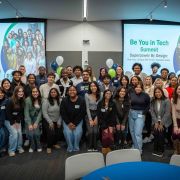
About
Through interdisciplinary and collaborative innovation, we are driving the future of the Information Age.
Opening its doors in 1999, the College of Information Sciences and Technology at Penn State is home to a thriving community of students, scholars, staff, alumni, and friends. Through innovative research and a student-centered approach to interdisciplinary education, we are delivering on the college's founding mission to prepare leaders for the Information Age. Our passionate students, renowned faculty, and supportive alumni network have propelled the college to forge new frontiers and create a meaningful impact at Penn State and beyond.

Recent News

July 23, 2025
University Libraries to host August speakers on AI, the Data Rescue Project

July 17, 2025
Let's give a 'We Are!' to these Penn Staters — July 17

July 14, 2025
Computer science grad makes $1 million estate commitment to the College of IST

July 10, 2025
In photos: 2025 Central Pennsylvania Festival of the Arts
Upcoming Events
Sep
15
IST Ace the Interview Workshop
Date & Time: September 15, 2025, 6:00 pm–7:00 pm
Location: Westgate Building | E215
Sep
03
IST Career Fair Prep Days: Professional Headshots
Date & Time: September 3, 2025, 9:00 am–3:00 pm
Location: Westgate Building | E215
Sep
04
IST Career Fair Prep Days | Day 2
Date & Time: September 4, 2025, 9:00 am–3:00 pm
Location: Westgate Building | Second Floor Hallway & E215
Sep
03
IST Career Fair Prep Days | Day 1
Date & Time: September 3, 2025, 9:00 am–3:00 pm
Location: Westgate Building | Second Floor Hallway & E215









